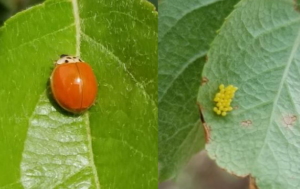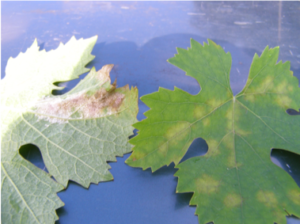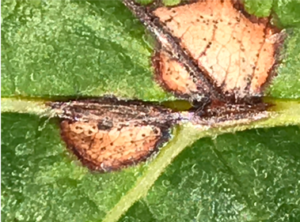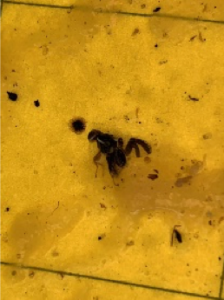Peach:
Oriental Fruit Moth: Second generation timings are updated below. Second flight adults started this past week in southern counties and are about to start this coming week in northern counties. According to the model, treatments for the second generation should be going on now in southern counties, and should start next week in northern counties.
| OFM 2nd Degree Day (DD) Timing | ||||
| Insecticide Type | ||||
| County/Region | Biofix | DD by 6/19 base 45 | Conventional
1150-1200, 1450-1500 |
Diamide
1075-1150, 1375-1450 |
| Gloucester – Southern | 4/8 | 1428
|
1st – past
2nd – 6/20-6/22 |
1st – past
2nd – 6/17-6/20 |
| Hunterdon – Northern | 4/16 | 960 | 1st – 6/17-6/20
2nd – too far off |
1st – past
2nd – too far off |
Peach Scab: Maintain good coverage with captan or other effective fungicides until July, where scab was an issue last year.
Brown Rot: After pit hardening growers may safely switch to a sulfur based program on late variety peaches where no scab was present last year. Pre-harvest programs for early peaches may rely on captan alone at the present time. As we approach ripening of midseason varieties growers should begin applying highly effective materials that include DMI, SDHI, and QoI chemistries beginning 3 weeks prior to harvest. Where bacterial spot is severe, or in blocks with significant amounts of pit damage, symptoms of which are now appearing, growers may wish to take a cautious approach by maintaining captan in cover sprays. Fruit that is pit damaged will be bleeding and when cut the area of bleeding will extend through the flesh directly to the pit.
Bacterial Spot: This disease is still present, and has increased in severity, especially in some nectarine plantings in northern counties. See previous newsletters for controls.
Apple:
Codling Moth (CM): A biofix was set for CM on April 25th in southern counties and on May 1 in Hunterdon County. Although we are past the model timings for CM, some orchards continue to experience trap captures above threshold. Growers should continue to treat for this insect as long as trap counts are above the treatment threshold of 5 males per trap. The average trap capture on many farms continues to indicate CM populations above this threshold.
Tufted Apple Budmoth (TABM): A biofix for TABM was set in southern county orchards on 4/25. The fourth alternate middle application for TABM will be this week in southern counties. A number of sites in northern counties have high trap counts. If we were still using an organophosphate-based program, this would probably spell trouble. However, management practices have changed, and we have not seen problems in recent years.
Aphids, Green apple aphid and Spirea aphid complex: Populations are starting to build in a number of orchards. Remember that this is an insect that we can tolerate to at least when 50% of terminals are infested with healthy colonies. These aphids DO NOT transmit Fire Blight or other diseases. As populations start to build, they will attract a number of predators, like the lady beetles below.

Figure 1. Lady beetle adult and egg mass on apple. Photo – A. Atanassov.
Potato Leafhoppers (PLH): PLH is now starting to get established in southern orchards. Potato leafhoppers should not be tolerated especially in new plantings and orchards where fire blight is present as they can vector the disease. Most materials that control leafhoppers will also control aphids. These include the neonicotinoids and Sivanto. Do not use Actara, Admire or Belay if flowering weeds and clover are present in the groundcover.
Grapes:
We are now past bloom in southern counties so summer diseases become the focus. Downy Mildew has been reported in some blocks. Black rot leaf lesions have also been seen.

Figure 2. Downy mildew on grape leaf. Photo – D. Schmitt.

Figure 3. Black rot on grape leaf. Photo – D. Schmitt.
A biofix was set for Grape berry moth in southern counties on 5/13. As of 6/19 we have accumulated 846 DD base 47.14 deg F in southern counties. The target for Intrepid and Altacor is after 810 DD have accumulated. Other materials can be applied a few days later.
| WEEK END | GBM | GRB |
| 6/1/2019 | 0 | |
| 6/8/2019 | 9 | |
| 6/15/2019 | 6 | 0 |
Scouting Calendar Tree Fruit Southern Counties
The following table is intended as an aid for orchard scouting. I t should not be used to time pesticide applications. Median dates for pest events and crop phenology are displayed. These dates are compiled from observations made since 1995 in Gloucester County. Events in northern New Jersey should occur 7-10 days later.
Pest Event or Growth Stage |
Approximate Date | 2019 Observed Date |
Bud Swell (Redhaven) |
March 23 +/- 15 Days | March 25 |
1/4″ Green Tip Red Delicious |
March 31 +/- 13 Days | March 27 |
Pink Peach (Redhaven) |
April 4 +/- 15 Days | April 4 |
Tight Cluster Red Delicious |
April 9 +/- 13 Days | April 8 |
Oriental Fruit Moth Biofix |
April 9 +/- 13 Days | April 8 |
Full Bloom Peach (Redhaven) |
April 9 +/- 14 Days | April 9 |
Pink Apple (Red Delicious) |
April 14 +/- 12 Days | April 16 |
Codling Moth Biofix |
April 27 +/- 13 Days | April 25 |
Green Peach Aphid Observed |
April 16 +/- 16 Days | |
Full Bloom Apple (Red Delicious) |
April 22 +/- 11 Days | April 20 |
Petal Fall (Redhaven) |
April 22 +/- 10 Days | April 19 |
Petal Fall (Red Delicious) |
April 27 +/- 14 Days | April 29 |
Shuck Split (Redhaven) |
April 30+/- 11 Days | April 24 |
First PC Oviposition Scars Observed |
May 3 +/- 18 Days | April 23 |
Tufted Apple Bud Moth Biofix |
May 4 +/- 10 Days | April 8 |
San Jose Scale Crawlers |
June 2 +/- 8 Days | May 24 |
Pit Hardening Peach |
June 16 +/- 8 Days | June 10 |
Tree Fruit Trap Counts – Southern Counties
| Weekending | STLM | TABM-A | CM | AM | OFM-A | DWB | OFM-P | TABM-P | LPTB | PTB |
| 4/27 | 8 | 1 | 3 | 110 | 29 | 0 | ||||
| 5/4 | 4 | 5 | 6 | 34 | 17 | 1 | 0 | |||
| 5/11 | 2 | 8 | 5 | 31 | 5 | 5 | 0 | |||
| 5/18 | 2 | 32 | 8 | 21 | 23 | 2 | 11 | 34 | ||
| 5/25 | 2 | 34 | 7 | 0 | 39 | 0 | 32 | 34 | ||
| 6/1 | 1 | 51 | 11 | 1 | 71 | 1 | 56 | 47 | ||
| 6/8 | 13 | 25 | 6 | 14 | 2 | 26 | 56 | |||
| 6/15 | 20 | 8 | 3 | 51 | 83 | 3 | 11 | 33 |
Tree Fruit Trap Counts – Northern Counties
| Weekending | STLM | TABM-A | CM | AM | OFM-A | DWB | OBLR | OFM-P | TABM-P | LPTB | PTB |
| 4/6 | 0.3 | ||||||||||
| 4/13 | 2 | ||||||||||
| 4/20 | 10 | 0 | 0.2 | 0.9 | |||||||
| 4/27 | 9 | 0 | 0 | 4 | 9.5 | 0 | |||||
| 5/4 | 9 | 0.1 | 0.2 | 7 | 0 | 0 | 17.1 | 0.2 | 0 | ||
| 5/11 | 10 | 0.6 | 1.2 | 4 | 0 | 0 | 5.8 | 2 | 2.5 | 0 | |
| 5/18 | 6 | 2.7 | 0.8 | 5 | 0 | 0 | 5.6 | 5.2 | 1.4 | 0 | |
| 5/25 | 3 | 13.3 | 2.9 | 3 | 2 | 0 | 1.1 | 10.8 | 4.5 | 0 | |
| 6/1 | 5 | 22.4 | 3.2 | 4 | 4 | 0.5 | 3.1 | 14.7 | 5.7 | 0 | |
| 6/8 | 8 | 40.4 | 3.8 | 1 | 1.3 | 2 | 1.7 | 32.5 | 8.3 | 0.3 | |
| 6/15 | 27 | 44 | 3 | 2 | 2 | 17 | 2 | 52 | 2.4 | 1.3 |
Blueberry
Blueberry Maggot (BBM): The first capture of blueberry maggot adults was on Friday 6/14 in an unsprayed field near Hammonton. Any grower who is exporting fruit to Canada needs to be on a regular schedule that targets both BBM and SWD.

Figure 4. Blueberry maggot adult on sticky trap. Photo – N. Freeman.
Spotted Wing Drosophila (SWD): Both males and females continue to be captured, with numbers per trap increasing slightly since the previous week. This is the main insect to control at this time, as well as through the entire ripening process. Population pressure will get more intense as the population increases, making protection even more important by the time you are in the middle of ‘Bluecrop.’
Scale: The level of fruit injury has increased since the previous week, showing an increase in crawler activity. Make sure to note the fields where scale injury is present in the cull boxes by the sorting lines. These fields should be scheduled for treatment in the beginning of August when the second generation crawlers are active. We will be setting additional traps to time second generation crawler emergence later in the season.
Aphids: Aphid populations decreased this past week to an average of .62% of new terminals infested. Where present, colony size increased slightly to 2-5 aphids per shoot. For those growers who have done a good job of aphid control, no additional targeted applications should be needed. Remaining population should be suppressed by the SWD treatments being applied.
Oriental Beetle (OB): The OB emergence is well underway. Populations will continue to build during the rest of June and early July. Growers who are treating for this insect and have not yet done so, will probably have to wait until the fruit is off the bushes in order to get equipment in. However, this means that only Duke and other early fields will be able to be treated if not already done, since treatments need to be applied by mid-July. Otherwise this year’s grubs will be too big to be controlled by the Admire.
Leafroller larval presence and injury: Some larvae are still present, and have increased slightly at 0.07 percent per shoots infested. This is still a very low number that does not merit special treatments.
Traps
Atlantic County Traps
| Week Ending | SWD | OB | BBM |
| 6/8 | 1.05 | 8.2 | 0 |
| 6/15 | 1.2 | 97 | 0 |
Burlington County Traps
| Week Ending | SWD | OB | BBM |
| 6/8 | 0.07 | 2.91 | 0 |
| 6/15 | 0.83 | 69 | 0 |

